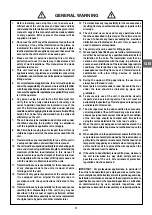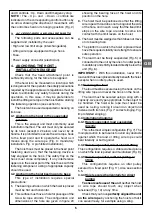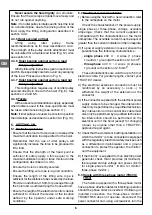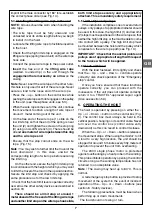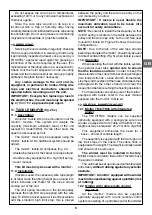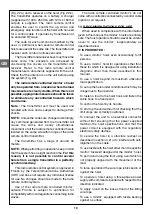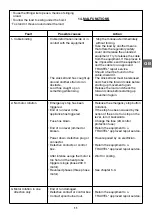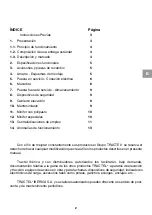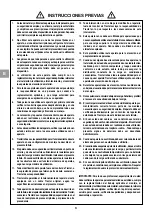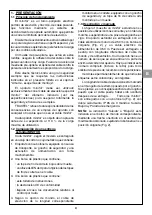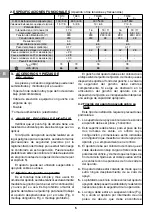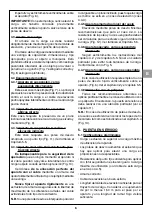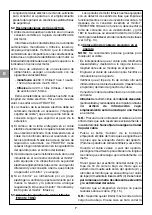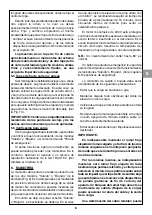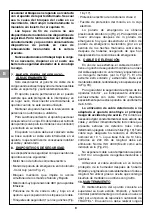
8
• Keep all obstacles away from the lifting wire rope
and load.
• Check that the loose strand is free along its entire
length.
• Do not allow the loaded strand to become loose
if the load is not stably bearing on a sufficiently strong
support.
• Do not apply short successive actions on the
pushbuttons.
IMPORTANT :
The loose strand of the wire rope must be kept
away from the loaded strand, and more
particularly, when two loaded strands are used
with tackle so that the loose strand does not
become tangled with the loaded strands.
For the same reasons, the loose wire rope
strand must be kept away from any obstacle
which could catch it and you should be careful
to prevent the loose strand from becoming
tangled in itself; this could result in preventing
the low limit stop attached to the loose strand
from reaching the stopping mechanisms (limit
stop levers) on the unit. Blockage of the loose
strand when moving up (load moving down)
could result in rupture of the wire rope and the
load falling.
Deformation of the wire rope can also cause
the wire rope to block in the hoist or on contact
of the deformed part with the hoist. Whatever
the cause of the wire rope movement becoming
blocked, the hoisting operation should be
stopped immediately. See section 13.
The limit stops are not control components
but safety components. These should never be
used intentionally in this respect and only serve
as stopping mechanisms in the event of
unintentional overshoot of the planned travel
distance.
Never park or work under the load. If
necessary, set up a safety barrier around the area
under the load.
7. SHUTDOWN – STORAGE
Do not disconnect the wire rope hook from the
load until the load is stable and firmly bearing on a
sufficiently strong support.
The hoist can remain in position provided it is
properly sheltered from weather and located in a dry
location. Disconnect the unit electrically when not
in use.
Make sure the hoist cannot be used by
unauthorized persons.
For storage, the unit can be stored in its case.
The wire rope must be removed from the unit
(except those models having a winder) and rolled
on its reel.
The unit must never be set on its base when the
wire rope is engaged in the unit as this would result
in bending and damaging the wire rope.
8. SAFETY DEVICES
The hoist is provided with the following safety
devices :
• A no-current brake motor.
• Emergency stop control on control box – Red
button (see Fig. 2).
• Mechanical interlock, prohibiting simultaneous
action of Up and Down controls.
• Very-low voltage control (48 V) for three-phase units.
• High and low limit levers on unit, working with stops
on wire rope.
• Safety latches (1) on hooks (Figs. 16 and 17)
• Electrical protection for control box: class 2.
• Control protection fuse, in electrical unit.
The emergency stop function is ensured by
pressing the red button (Fig. 2). To restart the unit
after an emergency stop, the emergency stop
button must be unlocked by turning it in the direction
of the arrows marked on the button, after having
ensured that all the emergency conditions have
been eliminated.
9. LIFTING WIRE ROPE
The minifor
™
wire rope is equipped with a safety
hook at one of its ends. The hook is mounted on a
wire rope loop equipped with a lug crimped in a metal
sleeve (see Fig.17). The other end is welded and
ground. This end must be maintained welded,
rounded and free of any irregularities (see Fig. 18).
To ensure safe use of the minifor
™
hoists, they
must only be used with the minifor
™
wire rope
specially designed for the hoist (diameter of 6.5 mm).
Use of a damaged or inappropriate wire rope
represents a serious risk of accident and failure.
The condition of the wire rope should be monitored
regularly and the wire rope should be immediately
eliminated if it shows any sign of damage such as
deformation, bending or broken wires (Fig. 19).
Any wire rope whose nominal diameter has been
reduced by 10% or which has more than 10 broken
wires over a length of 200 mm should be eliminated.
Standard ISO 4309 (Measure as shown in Fig. 20).
GB



